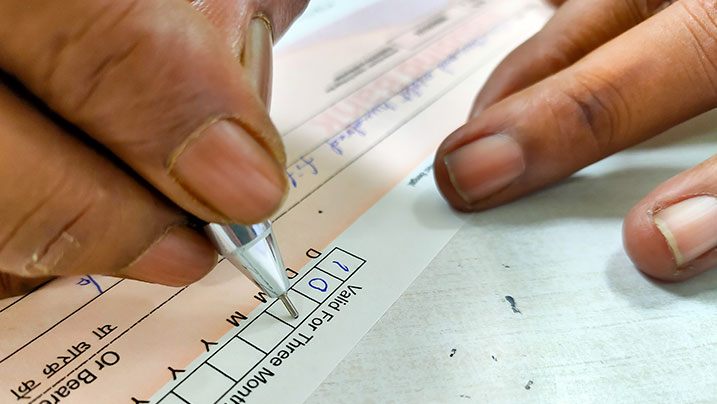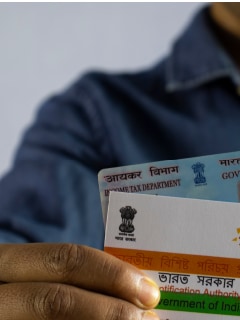CKYC Registry
-
Customer Service Contact us Service request Locate a branch
Find all the help you need
Scan the QR, get our app, and find help on your fingertips

Help CenterSupport topics, Contact us, FAQs and more
-
Login
Are you ready for an upgrade?
Login to the new experience with best features and services
-
Login
Are you ready for an upgrade?
Login to the new experience with best features and services
- Accounts
-
Deposits
IDFC FIRST Bank Deposits
View all Deposits -
Loans
IDFC FIRST Bank Loans
View all Loans - Wealth & Insure
-
Payments
IDFC FIRST Bank Payments
View all Payments -
Cards
IDFC FIRST Bank Cards
View all Cards - Blogs
- Corporate Account
-
Cash Management Services
IDFC FIRST Bank Cash Management Services
View all Cash Management Services - Supply Chain Finance
-
Corporate Lending
IDFC FIRST Bank Lending
View all -
Treasury
IDFC FIRST Bank Treasury
See more details - NBFC Financing
Support topics, Contact us, FAQs and more
- IDFC FIRST Bank Accounts
-
Savings Account
-
Corporate Salary
Account -
Senior Citizens
Savings Account -
First Power
Account -
Current Account
-
NRI Savings
Account -
TASC Institutional
Account -
Savings Account
Interest Calculator
- IDFC FIRST Bank Deposits
-
Fixed Deposit
-
Recurring Deposit
-
NRI Fixed Deposit
-
Safe Deposit Locker
-
FD Calculator
-
RD Calculator
- IDFC FIRST Bank Loans
-
Personal Loan
-
Consumer Durable
Loan -
Home Loan
-
Business Loan
-
Professional Loan
-
Education Loan
-
New Car Loan
-
Pre-owned Car Loan
-
Two Wheeler Loan
-
Pre-owned Two
Wheeler Loan -
Commercial Vehicle
Loan -
Gold Loan
-
Loan Against Property
-
Loan Against Securities
-
Easy Buy EMI card
-
Personal Loan
EMI Calculator -
Education Loan
EMI Calculator -
Home Loan
EMI Calculator -
EMI Calculator
-
Personal Loan Eligibility Calculator
- IDFC FIRST Bank Wealth & Insure
-
FIRST Select
-
FIRST Wealth
-
FIRST Private
-
Mutual Funds
-
Sovereign Gold Bond
-
Demat Account
-
Term Insurance
-
Life Insurance
-
Health Insurance
-
General Insurance
-
Bonds
-
Loan Against
Securities -
Portfolio Management
Service
- IDFC FIRST Bank Payments
-
FASTag
-
Credit Card
Bill Payments -
UPI
-
Funds Transfer
-
Forex Services
-
Pay Loan EMI
- IDFC FIRST Bank Cards
-
Ashva :
Metal Credit Card -
Mayura :
Metal Credit Card -
FIRST Millennia
Credit Card -
FIRST Classic
Credit Card -
FIRST Select
Credit Card -
FIRST Wealth
Credit Card -
FIRST WOW!
Credit Card -
Deals
-
Debit Cards
-
Co-branded Cards
-
Credit Card
EMI Calculator -
FIRST Corporate
Credit Card -
FIRST Purchase
Credit Card -
FIRST Business
Credit Card
- Premium Metal Credit Cards
-
AshvaLifestyle1% Forex₹2,999
-
MayuraLifestyleZero Forex₹5,999
-
FIRST PrivateInvite Only
- Best for travellers
-
MayuraZero ForexMetal₹5,999
-
Ashva1% ForexMetal₹2,999
-
FIRST WOW!Zero ForexTravelLifetime Free
-
FIRST SWYPTravel OffersEMI₹499
-
FIRST Select1.99% ForexLifestyleLifetime Free
-
FIRST Wealth1.5% ForexLifestyleLifetime Free
-
Club VistaraTravelLifestyle₹4,999
-
IndiGo IDFC FIRST Dual Credit CardTravelLifestyle₹4,999
- Max benefits, Free for life
-
FIRST Classic10X RewardsShoppingNever Expiring Rewards
-
FIRST Millennia10X RewardsShoppingNever Expiring Rewards
-
FIRST Select10X RewardsLifestyle1.99% Forex
-
FIRST Wealth10X RewardsLifestyle1.5% Forex
-
FIRST WOW!RewardsTravelZero Forex
-
LIC ClassicRewardsInsuranceShopping
-
LIC SelectRewardsInsuranceShopping
- Reward Multipliers
-
AshvaLifestyleMetal₹2,999
-
MayuraLifestyleZero Forex₹5,999
-
FIRST ClassicNever Expiring RewardsShoppingLifetime Free
-
FIRST MillenniaNever Expiring RewardsShoppingLifetime Free
-
FIRST SelectNever Expiring RewardsLifestyleLifetime Free
-
FIRST WealthNever Expiring RewardsLifestyleLifetime Free
- Rewards & Credit on UPI
-
FIRST Power+FuelUPI₹499
-
FIRST PowerFuelUPI₹199
-
FIRST EA₹NVirtual1% Cashback₹499
-
FIRST DigitalVirtualUPI₹199
-
IndiGo IDFC FIRST Dual Credit CardUPITravelDual cards
- Fuel and Savings
-
FIRST PowerRewardsUPI₹199
-
FIRST Power+RewardsUPI₹499
-
LIC ClassicRewardsInsuranceShopping
-
LIC SelectRewardsInsuranceShopping
- Express and Flaunt
-
AshvaMetal1% Forex₹2,999
-
MayuraMetalZero Forex₹5,999
-
FIRST SWYPEMIOfferMAX₹499
-
FIRST MillenniaRewardsShoppingLifetime Free
- FD Backed rewarding Credit Cards for all
-
FIRST EA₹NVirtualCashback₹499
-
FIRST WOW!Zero ForexTravelLifetime Free
-
CreditPro Balance TransferTransfer & SaveReduce InterestPay Smartly
- IDFC FIRST Bank NRI Forex Solutions
-
Send money to India-Wire transfer
-
Send money to India-Digitally
-
Send money abroad
-
Max Returns FD (INR)
- IDFC FIRST Bank MSME Accounts
-
Platinum Current
Account -
Gold
Current Account -
Silver Plus
Current Account -
Merchant Multiplier
Account -
Agri Multiplier
Account -
TASC Institutional
Account -
Dynamic Current
Account -
World business
Account -
First Startup
Current Account
- IDFC FIRST Bank Business Loans
-
Business Loan
-
Professional Loan
-
Loan Against Property
-
Business Loan for Women
-
Working Capital Loan
-
Construction Equipment Loan
-
Machinery Loan
-
Healthcare Equipment Loan
- IDFC FIRST Bank Business Solutions
-
Payment Solutions
-
Tax Payments
-
Doorstep Banking
-
Point of Sale (POS)
-
Escrow Accounts
-
NACH
-
Payment Gateway
-
UPI
-
Virtual Accounts
-
As per amendment in the Income Tax Rules, PAN or Aadhaar are to be mandatorily quoted for cash deposit or withdrawal aggregating to Rupees twenty lakhs or more in a FY. Please update your PAN or Aadhaar. Kindly reach out to the Bank’s contact center on 1800 10 888 or visit the nearest IDFC FIRST Bank branch for further queries.
-
-
Most Searched
Sorry!
We couldn’t find ‘’ in our website
Here is what you can do :
- Try checking the spelling and search
- Search from below suggestions instead
- Widen your search & try a more generic keyword
Suggested
Get a Credit Card
Enjoy Zero Charges on All Commonly Used Savings Account Services
Open Account Now
Although blank cheques and crossed cheques are common, they are not the only types of cheques you can issue. A cheque is written by an individual or an organisation for large payments. Unlike cash, cheque payments are recorded with the bank and reflected in your bank account. But what is a cheque?
Meaning of Cheque
A cheque is a paper instrument that orders the bank to transfer money from the sender’s account to another account. It is issued to a current or savings account holder to conveniently transfer money within and outside the bank. A cheque is a common method of money transfer among merchants and small businesses.
Cheques are negotiable instruments covered under the Negotiable Instrument Act, of 1881. In a cheque transaction, three parties are involved namely, the drawer, the drawee, and the beneficiary or payee. The drawer writes the cheque in the name of the beneficiary, requesting the bank to transfer the mentioned amount to the beneficiary from their account. The banks are the drawer in cheque payments.
READ MORE
There are mainly ten types of cheques in India that you should know about.” The ten types of cheques include:
1. Bearer Cheque
A bearer cheque is the type of cheque that allows the person bearing or carrying the cheque to the bank to receive the payment specified on the cheque. These cheques have the words “or bearer” printed in front of the name of the payee. It means that the amount of the cheque issued can be either received by the payee or the bearer. It also makes a bearer cheque transferable, as anyone who is carrying it can receive the payment. The bank need not request the authorisation of the issuer to make the payment of this cheque.
2. Order cheque
The second type of cheque is the order cheque. An order cheque is the one that has the words “or bearer” cancelled out. It means that only the individual whose name is mentioned as the payee can receive the specified sum of money. In this case, the bank does not check the bearer’s identity before making the payment.
3. Crossed cheque
A crossed cheque is a type of cheque where the issuer makes two slanted parallel lines on the top left corner of the cheque, with the word ‘a/c payee’ written. It means that the specified sum of the cheque, regardless of who is handing it over, will only be transferred to the individual/organisation whose name is mentioned as the payee. A crossed cheque is also safer because it can be cashed only at the payee’s bank.
4. Open cheque
An open cheque does not have crossed lines, and hence, is also called an uncrossed cheque. An open cheque can be cashed at either of the banks, namely, the payer’s bank or the payee’s bank. Also, an open cheque is transferable by the payee, which means they can make someone else the payee. The issuer of the open cheque is required to sign on both the front and back of the cheque.
5. Post-dated cheque
A post-dated cheque bears a date later than the date it was issued on. It can only be cashed after the date specified by the payer. The post-dated cheque can be valid after the mentioned date but not before it. Hence, even if it is presented to the bank, the bank will not process it until the mentioned date.
6. Stale cheque
A stale cheque has already passed its validity date and can no longer be cashed. Currently, a cheque is considered valid until three months from its issued date.
7. Traveller’s cheque
Issued by a bank, a traveller’s cheque can be cashed by the payee at another bank in another country. The payment will be received in that country’s currency. It becomes useful when you are heading on a foreign trip and do not wish to carry too much cash. A traveller’s cheque does not have an expiry date.
8. Self cheque
A self-cheque has the word ‘self’ written as the payee. It is used by the issuer to withdraw money from their bank account. A self-cheque can be cashed only at the issuer’s bank.
9. Banker’s cheque
A banker’s cheque is issued by the bank itself. A bank issues a banker’s cheque on behalf of an account holder to issue payment to another person in the same city. Banker’s cheques are only valid for three months, however, post their validity period they can be revalidated if certain conditions are fulfilled.
10. Blank cheque
A blank cheque is one that has the sign of the issuer, and no other details are filled in. Blank cheques pose a high risk because if lost, anyone who finds it can fill in any amount and issue it to themselves.
A cheque is a document that tells your bank to transfer the mentioned amount to a person or organisation. There are mainly ten types of cheques in India that you should know about.
Features of a cheque
The following are the common features of a cheque
• An individual holding savings or current account can issue a cheque.
• The payee once mentioned cannot be edited or changed. A fresh cheque leaf needs to be issued in case of changing the payee.
• Similarly, the amount mentioned on the cheque cannot be altered.
• A cheque must be signed before submitting otherwise it is considered invalid.
• A cheque carries validity if it is signed and dated. They are usually valid from the date mentioned on them. A cheque older than 6 months is called a stale cheque however, they are still valid and can be used for transactions.
• Signed cheques without any amounts mentioned in them are known as blank cheques.
• A cheque consists of cheque number, MICR, and entries to mention the payee’s name, drawn amount, and signature of the drawee.
Advantages and disadvantages of a cheque
Cheques accompany several upsides and downsides. Here are some notable advantages and disadvantages of using cheques.
Advantages of using cheques
• They are a better alternative to carrying cash.
• With a unique number assigned to every cheque leaf, they are easier to track down if lost.
• You can issue cheques to other parties since they are negotiable instruments.
• Several bank digital kiosks also process cheque transactions digitally so, you don’t require to visit the bank always.
Downsides of using cheques
• Sometimes, banks may deny cheque processing for a few reasons, such as low account.balances, signature mismatch and more because they are not legal tenders.
• Digital money transfer methods are becoming popular since cheques are a bit time-consuming to process payments.
• Cheques are issued only to account holders, so anyone who wishes to use cheques first must open a bank account.
How to apply for a new chequebook
Applying for a new chequebook has now become convenient as you can get it through various online and offline channels. Use any of the below-mentioned methods to get a new chequebook.
• Online mode – You can log into your net banking account and navigate to the services section to request a new chequebook. After paying the required amount, you will receive it at your registered mailing address. If you are an IDFC FIRST Bank account holder, new chequebook issuance is completely free of charge.
• Mobile app – Like net banking, you can also use your mobile banking app to apply for a new chequebook. The process is similar to net banking and consumes hardly a couple of minutes.
• ATM – If you don’t have an active net banking or mobile banking service, you can visit your nearby ATM and access your account using the debit card and pin. Later, navigate to the services section, choose the ‘issue a new chequebook’ option and proceed as instructed.
• Bank branch – Alternatively, you can visit the bank branch during active hours and apply for a new chequebook.
What is a cheque number?
Every cheque carries a unique 6-digit number inscribed on the bottom of the cheque leaf. This number is known as the cheque number, and it is used to identify the status of the cheque. The cheque number is followed by a MICR number and a portion of the account number with which the account number is linked.
To find the cheque number, you can look at the bottom left corner of your cheque leaf. The first 6 digits that appear on the leaf are your cheque number. The remaining numbers denote the details of issuing branch, city, and the account linked.
How to write a cheque?
Specific steps are involved while writing a cheque. One must follow all the steps precisely when filling it out. Here are the quick and simple steps to write a cheque.
1. Begin with crossing the cheque. Crossing a cheque means drawing parallel lines at the left top corner. If it is an account payee cheque, write ‘Account Payee’ between the parallel lines.
2. Fill out the space provided for entering the date and payee’s name.
3. Subsequently, write the amount in words and end it with the word ‘only’. It marks the end of the amount that you have entered.
4. Now enter the amount in numerals and end it with ‘/- ‘.
5. Verify all your entries and sign at the bottom of the cheque to authorise the cheque.
6. For specific reasons, the bank may also ask you to enter your account name and number at the back of the cheque leaf.
Things to know before writing a cheque
Banks take utmost care when processing cheque transactions for security reasons. So, individuals must be cautious when filling out details. The following are the important things to keep in mind while writing a cheque.
• When filling out details, never leave spaces to avoid any chances of misuse.
• Do not overwrite or cross-mark on the cheque as unclear entries may reject your cheque.
• Never leave any column blank for security reasons.
• Mark your signature clearly and use the same signature as present in the bank record.
• Do not staple or fold the cheque as it may corrupt the MICR code.
Parties to cheque
Cheque payment includes multiple parties, and the payment processing takes place in chronological order. Here are the various parties included.
1. Drawer – A drawer is a person who writes the cheque and authorises the bank to withdraw money from his/her account and pay it to the beneficiary. In simple terms, the drawer is the account holder who issues the cheque.
2. Drawee – It is the bank that initiates the cheque payment process. The cheque is drawn at the drawee bank.
3. Payee – It is another term used for the beneficiary. The payee is the person who receives the payment from the cheque-holder through the drawee bank.
4. Endorser – If the payment rights are transferred to a third party, the payee, in this case, becomes the endorser.
5. Endorsee – The endorsee is the party to whom the payment rights are passed from the payee (the endorser).
So that was everything about the types of cheques that you can issue and receive. To know more about cheques, head over to the IDFC FIRST Bank website, where you can find detailed explanations pertaining to different kinds of cheques they offer. To know more about applying for new products, you can reach out to IDFC FIRST Bank Customer Service on 1800 10 888.
Frequently Asked Questions
Can I write a cheque if I don’t have a bank account?
No, only the account holders receive cheque book which they can use to transfer money or make payments. However, you can encash a cheque drawn in your name even without a bank account.
Can I use a cheque instead of cash for payment?
Yes, a cheque can be used instead of cash payment if the merchant or the shop accepts cheque payments.
When does the bank refuse to make cheque payments?
There are certain situations in which the bank may refuse to process the cheque payments, such as those mentioned below.
• If the date is missing on the cheque leaf, including mandatory details such as the beneficiaries name, issuer’s sign and more, a cheque may be rejected.
• If the cheque was issued before 3 months.
• If the post-dated cheque is issued before the mentioned date on the cheque.
• If there are overwriting and unclear details.
• Mutilated and damaged cheques also lead to rejection.
What happens if my cheque gets misplaced during the clearing process?
In case the cheque gets misplaced from the bank side, the bank is held responsible. It informs the issuer immediately and compensates them as per the bank’s prevailing rules and regulations.
Who has the authority to sign the cheque?
The drawer or the cheque holder has the authority to sign the cheque. An individual impersonating the cheque owner’s sign is considered an offender under the law.
How much time does the bank take to clear a cheque?
Usually, the banks take 1-2 business days to process and clear the cheque payment. The time may increase depending on the day of the week since it is a manual clearing process.
What is a bounced cheque?
A bounced cheque is a cheque rejected by the bank for not maintaining enough balance in the bank account to initiate the payment process. To avoid cheque bounce, individuals must ensure they have adequate money in their bank account. Several banks also charge a cheque bounce penalty for the same. However, IDFC FIRST Bank follows the zero-fee banking notion, where the issuer is not charged any fee if their cheque gets bounced for some unavoidable reasons.
Disclaimer
The contents of this article/infographic/picture/video are meant solely for information purposes. The contents are generic in nature and for informational purposes only. It is not a substitute for specific advice in your own circumstances. The information is subject to updation, completion, revision, verification and amendment and the same may change materially. The information is not intended for distribution or use by any person in any jurisdiction where such distribution or use would be contrary to law or regulation or would subject IDFC FIRST Bank or its affiliates to any licensing or registration requirements. IDFC FIRST Bank shall not be responsible for any direct/indirect loss or liability incurred by the reader for taking any financial decisions based on the contents and information mentioned. Please consult your financial advisor before making any financial decision.
The features, benefits and offers mentioned in the article are applicable as on the day of publication of this blog and is subject to change without notice. The contents herein are also subject to other product specific terms and conditions and any third party terms and conditions, as applicable. Please refer our website www.idfcfirstbank.com for latest updates.























